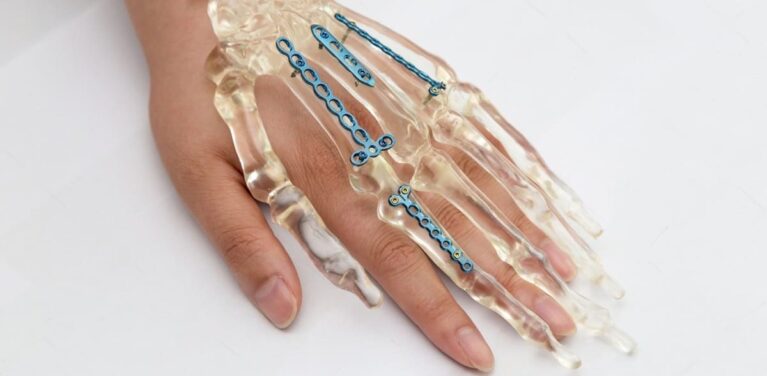Mini fragment implants are small orthopedic devices used primarily in the surgical treatment of fractures, particularly in areas with delicate or small bones such as the hands, wrists, face, and feet. These implants are designed to provide stable fixation and support for bone fragments, ensuring proper alignment and promoting healing. Here’s an overview of their key aspects:
Design and Components
- Materials: Typically made from biocompatible materials such as titanium or stainless steel, which provide strength and minimize the risk of rejection by the body.
- Types: Includes screws, plates, and sometimes rods, all designed to be small and lightweight to match the anatomy of smaller bones.
- Shapes and Sizes: Available in various shapes and sizes to cater to different types of fractures and anatomical locations.
Applications
- Orthopedic Surgery: Used for fractures in the hands, wrists, feet, and other areas with small bones.
- Craniofacial Surgery: Utilized in facial reconstructive surgeries, including fractures of the jaw, cheekbones, and eye sockets.
- Pediatric Surgery: Sometimes used in children due to the smaller size of their bones.
Benefits
- Precision: Allows for precise alignment and stabilization of bone fragments, which is crucial for proper healing and function.
- Minimally Invasive: Smaller size facilitates less invasive surgical techniques, potentially reducing recovery time and minimizing scarring.
- Versatility: Can be used in various complex anatomical areas where larger implants would not be feasible.
Considerations
- Technical Expertise: Requires skilled surgical techniques due to the small size and delicate nature of the bones involved.
- Post-Operative Care: Monitoring is essential to ensure proper healing and to detect any complications such as infection or implant failure.
Innovations
- Bioabsorbable Implants: Some mini fragment implants are designed to be absorbed by the body over time, reducing the need for a second surgery to remove the implant.
- Customized Implants: Advances in 3D printing technology allow for the creation of customized implants tailored to the patient’s specific anatomy.
Mini fragment implants play a crucial role in modern orthopedic and reconstructive surgery, offering a reliable solution for the fixation of small bone fractures. Their development and refinement continue to improve patient outcomes and surgical success rates.
Importance of Mini Fragment Implants in Orthopedic Surgery
Mini fragment implants are crucial in orthopedic surgery for several reasons, particularly when dealing with fractures or reconstructive needs involving small bones. Here are some key points highlighting their importance:
Precision and Stability
- Accurate Alignment: Mini fragment implants provide precise alignment of bone fragments, which is critical for proper healing and restoration of function.
- Stable Fixation: They offer stable fixation, preventing movement of the bone fragments and allowing for proper bone healing.
Specialized Applications
- Small Bones: Ideal for fractures in small bones such as those in the hands, wrists, feet, and facial bones, where larger implants would be inappropriate.
- Complex Fractures: Suitable for complex and comminuted fractures (where the bone is broken into multiple pieces) that require meticulous reconstruction.
Minimally Invasive Techniques
- Less Tissue Disruption: Their small size allows for minimally invasive surgical techniques, which can reduce soft tissue damage, postoperative pain, and scarring.
- Quicker Recovery: Minimally invasive procedures often lead to shorter hospital stays and quicker recovery times.
Versatility
- Wide Range of Uses: Applicable in various types of surgeries, including orthopedic, craniofacial, and pediatric surgeries.
- Adaptability: Can be used in different anatomical locations and adapted for various fracture patterns and bone sizes.
Improved Outcomes
- Functional Restoration: Enhances the likelihood of restoring full function to the affected area, which is especially important in regions requiring high dexterity, like the hands.
- Aesthetic Results: In craniofacial surgery, they help achieve better aesthetic outcomes by precisely aligning bones and minimizing visible scars.
Patient-Specific Solutions
- Customization: Advances in technology allow for the customization of implants to fit the specific anatomy of the patient, improving the fit and function of the implant.
- Bioabsorbable Options: Some mini fragment implants are designed to be bioabsorbable, which means they gradually dissolve in the body, eliminating the need for a second surgery to remove the implant.
Technical Advances
- Materials: Made from biocompatible materials like titanium and stainless steel, ensuring durability and reducing the risk of rejection.
- Innovative Designs: Continuous improvements in design and materials enhance the performance and safety of these implants.
Pediatric Considerations
- Growth Compatibility: In pediatric patients, mini fragment implants accommodate the smaller size of children’s bones and are designed to support growth and development.
Overall, mini fragment implants are essential in orthopedic surgery due to their ability to provide precise, stable fixation in delicate and complex anatomical areas. They contribute to better surgical outcomes, faster recovery times, and improved overall patient care.



Leave A Comment